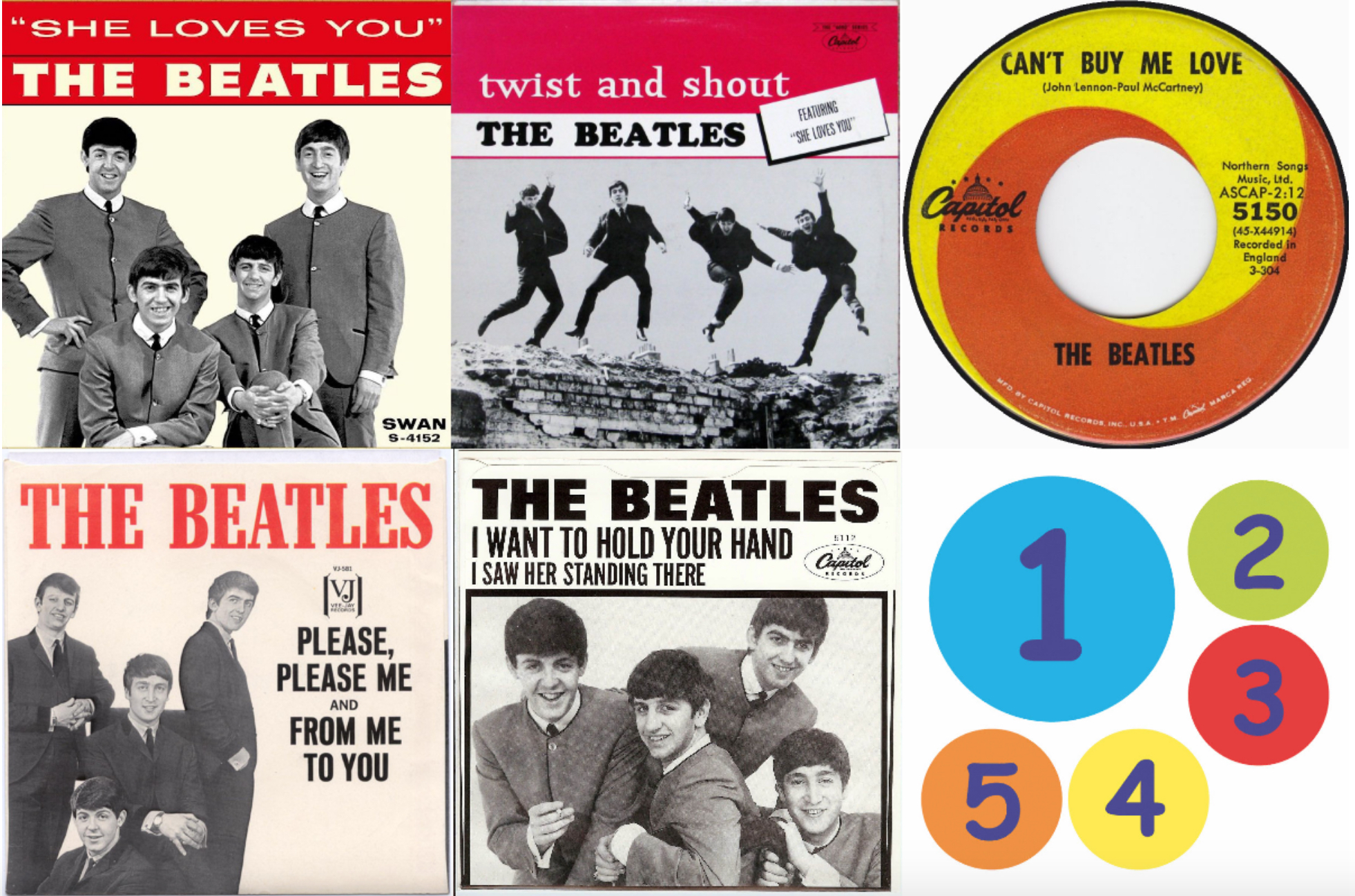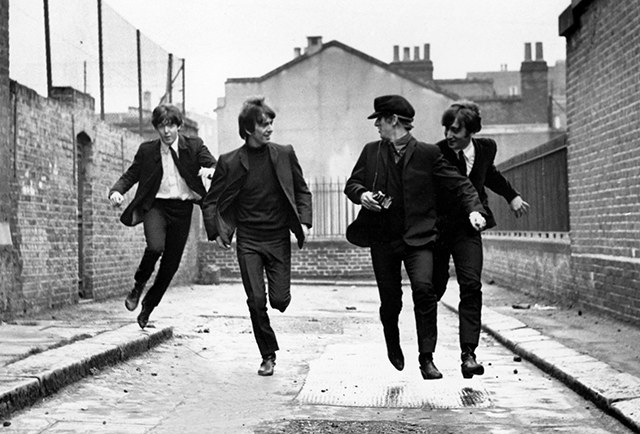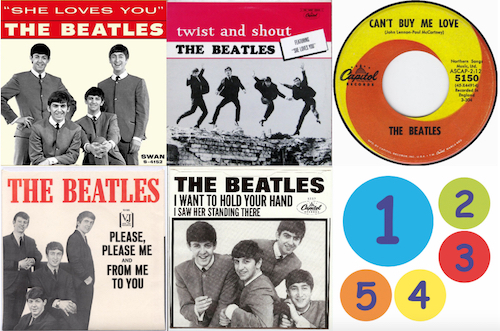
They might as well have called it Beatleboard. On the Hot 100 singles chart ending on April 4, 1964, The Beatles—a name that had meaning to very few Americans just a few months earlier—held the top five spots in Billboard, the country’s leading music trade publication.
Anyone perusing the chart would have seen this:
1. “Can’t Buy Me Love”
2. “Twist and Shout”
3. “She Loves You”
4. “I Want to Hold Your Hand”
5. “Please Please Me”
Never before in the history of Billboard had one artist dominated the top five positions.
And that wasn’t all. In addition to the five chart-toppers, the Beatles were represented by another seven titles on the chart that week: “I Saw Her Standing There” (#31), “From Me to You” (#41), “Do You Want to Know a Secret” (#46), “All My Loving” (#58), “You Can’t Do That” (#65), “Roll Over Beethoven” #(68) and “Thank You Girl” (#79). And several of those were B-sides—such was the pervasiveness of Beatlemania in early 1964.
Two more Beatles singles would join the club on the April 11 chart: “There’s a Place” and “Love Me Do” (the latter having been their first charter in the U.K., in the fall of 1962). That gave them 14 singles in the Hot 100.
At the very beginning of 1964, there wasn’t a Beatles song to be found on the chart, although the group had already been a phenomenon in England for more than a year. Then, on the Billboard chart ending Jan. 18, there they are, entering at #45 with “I Want to Hold Your Hand.” Topping the chart that week: Bobby Vinton’s “There! I’ve Said It Again.”
By the following week, the Beatles’ tune had jumped to #3, and with their arrival in America and first appearance on The Ed Sullivan Show in early February there was no stopping them. When “Can’t Buy Me Love” took over the #1 position, jumping straight up there from #27, it was replacing another Beatles record, “She Loves You,” which had held the spot for two weeks. And that single had replaced “I Want to Hold Your Hand,” which didn’t budge from the top for seven full weeks.

How this invasion of the charts became possible is another story in itself, involving the ownership rights of the group’s recordings. A peek at that top 5 reveals that only two of the songs, “Can’t Buy Me Love” and “I Want to Hold Your Hand,” were on Capitol Records, the label to which the Beatles were actually signed. The others were released on labels—Tollie (“Twist and Shout”), Swan (“She Loves You”) and Vee Jay (“Please Please Me”)—that had, for one reason or another, obtained the rights to those early recordings because Capitol, the American branch of Britain’s EMI, had at first passed on releasing those songs in the United States.
With the Beatle floodgate now wide open, virtually anything with their name on it was going to sell.
In fact, sitting at #85 on that April 4 chart was a single by the 4 Preps, “A Letter to the Beatles,” while at #42, by an entity called the Carefrees, sat “We Love You Beatles.” That was an understatement if ever there was one.
Watch the Beatles perform “Can’t Buy Me Love”
Related: Our feature story on the shredding delight of “Can’t Buy Me Love”
Books on The Beatles are available in the U.S. here and in the U.K. here.


5 Comments
Truly amazing, and indeed something that won’t be duplicated anytime soon. Something like The Beatles phenomenal impact on society doesn’t happen ever generation, or even ever century. I consider myself extremely luck to have “gotten in” on the last 3 yrs. of The Beatles, which only occurred because I had two older brothers which allowed me access to their record collections.
I remember this day. I was 9 years old. Since two months, my older brother (11) and I kept harassing our mother to buy us a Beatles record. So, for my birthday, exactly this April 4, I received this disc as a gift: on a pink sleeve, the front cover read I Want To Hold Your Hand Beatle Mania by The Schoolboys on Palace Records. What a deception! This was not a Beatles record, but five dudes playing ONLY 2 songs of our favorite band, I Want to Hold Your Hand and Twist And Shout. Mother, may God have your soul. But from that day on, I found a job as a newspaper deliverer in order to get myself records from The Beatles, on Capitol, Swan, Vee-Jay, Tollie and, naturally, later on Apple. What songs they have put on 45 R.P.M. from Can’t Buy Me Love to Day Tripper and Penny Lane to Come Together. Thanks, John, Paul, George, Ringo!
Love George’s quirky little look at the camera on the 0.46 second mark!
In the 1980s, many of The Monkees’ albums from the 1960s were reissued and had a resurgence in popularity. As a result, several of their albums charted simultaneously in the Billboard 200 chart in the mid-1980s. For example, in 1986, The Monkees had four albums in the chart: “Then & Now… The Best of The Monkees,” “More of the Monkees,” “The Monkees,” and “Pisces, Aquarius, Capricorn & Jones Ltd.” The renewed interest in The Monkees’ music during this time was due in part to the success of their television show, which was being rerun on MTV television and attracting a new audience. so – there’s that.
bradwww… In 1975, Led Zep had all 6 of their albums on Billboard simultaneously. Shortly after Prince died, he had 8 albums on Billboard, including #s 1, 2, and 6. But one act with 5 singles in the top 5 positions of the singles chart… that’s insane.